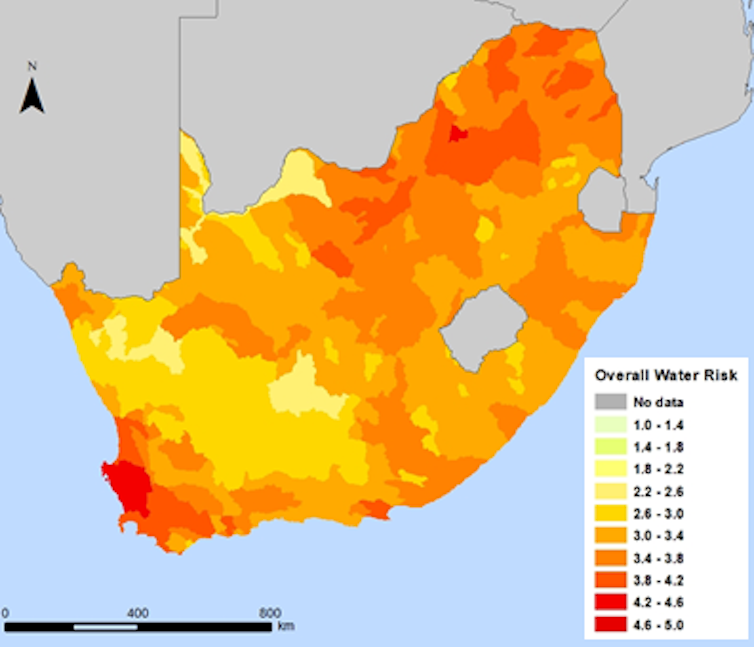Over the past week, water consumption in the city declined from 535 million litres per day to 526 million litres per day. (Njeri Mwangi/Reuters)
South Africa is often referred to as the 30th driest country in the world, a claim that’s based on its average annual rainfall of 500mm compared to the world average of 860mm.
National rainfall averages have a purpose. They do, however, have limited value where regional and local rainfall distribution varies considerably and when water security is threatened by recurring droughts, or when water use is poorly regulated and managed. Average rainfall data is meaningless when water demand exceeds supply.
This is true in South Africa. Since 2013 nearly every region in South Africa has experienced some form of drought and water shortages resulting in water restrictions in urban areas and in the agriculture sector.
Currently, the metro cities of Cape Town and Johannesburg have restrictions in place. Cape Town requires its agricultural sector to reduce water use by 60% and its citizens by 45%. Likewise, whole provinces, such as the Eastern Cape, large municipalities and numerous smaller towns have various levels of water restrictions in place and in some cases receive only intermittent supplies.
A reliable supply of water at an acceptable quantity and quality that’s not harmful to human health, livelihoods, development and the environment is essential for the future development of South Africa. Yet erratic rainfall and increasing water demand is increasing levels of water stress.
In 2013 a water stress survey placed South Africa in 65th position out of 180 countries, but by 2040 the water stress index is likely to rise to anything between 40% and 80%.
Crisis proofing South Africa’s water security is imperative, but it’s not clear how this can be attained. There’s no universal agreement on how water security is measured. Typically measurements include water availability, water risk and hazards, water use, access and equity in water, and the effect and frequency of floods and droughts. What’s often missing are ways of measuring adaptation and environmental sustainability that are likely to improve the chances of becoming water secure.
Hard challenges
South Africa can’t change the climate systems that influence weather variability and conditions. But it can do a lot to adapt to changing the future where parts of the country will get drier, warmer and the intervals between droughts will be shorter.
South Africa is a water stressed country. Indices show regions of high water demand, particularly in the south-western and eastern parts, and also in north. These regions are likely to become increasingly water stressed because of an over use of surface water followed by drought that will effect social and economic development.
 South Africa’s water stress index relative to global scores. World Wide Fund Water Risk Filter
South Africa’s water stress index relative to global scores. World Wide Fund Water Risk Filter
By 2035 water demand is expected to exceed supply by 10%. If planned water schemes aren’t carried out the Institute for Security Studies estimates that this gap could increase to 21%.
South Africa has a number of specific challenges that make it difficult for achieving water security. These include:
- The geographic position of a country that influences climate and weather systems.
- Rapid population growth and increasing water demand.
- Limited investment in water infrastructure and projects.
- Corruption and mismanagement of water resources resulting in public mistrust and lack of confidence in leadership of state departments.
- Fragile social and institutional capacity which threatens effective governance.
Action required
South Africa needs to do three things as a matter of urgency:
Close the gap on water supply and demand. This is primarily a function of the National Department of Water and Sanitation. Currently, however, the new Minister for Water and Sanitation, Gugile Nkwinti, has his hands full in fixing the department and attracting experienced personnel to senior vacant posts and new appointees to the National Water Advisory Committee.
Draft an integrated water security strategy that includes components that are measurable to enable progress to be tracked and government to be held accountable. The strategy already exists in a plethora of national policies, regulations and development plans, but the transition to a water secure country must be measurable and capable of improving water-related decisions and plans.
Improve water quality infrastructure. This includes water treatment plants and drainage systems that pollute freshwater systems and storage dams. It’s understandable that the supply of water has taken centre stage, but the general neglect of surface water quality is an issue that can’t be ignored any longer. Only a third of South Africa’s rivers are in a good condition while the cost of restoring degraded river systems is increasingly prohibitive.
South Africa’s developmental agenda will be well served by ensuring a reliable and secure water management system. Water security helps to reduce poverty, advances education, supports productivity and increases living standards. Most of all an improved quality of life, especially for the poor and most vulnerable, will result from good water governance.
No country or city can afford to be without a reliable source of water. A no regrets strategy takes a precautionary approach that avoids a water crisis from escalating into failure.
Kevin Winter, Senior Lecturer in Environmental & Geographical Science, University of Cape Town
This article is republished from The Conversation under a Creative Commons license. Read the original article.
